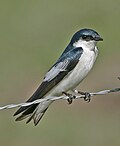Tachycineta
| Tachycineta | |
|---|---|

| |
| Tree swallow (Tachycineta bicolor) | |
| Scientific classification | |
| Kingdom: | Animalia |
| Phylum: | Chordata |
| Class: | Aves |
| Order: | Passeriformes |
| Family: | Hirundinidae |
| Subfamily: | Hirundininae |
| Genus: | Tachycineta Cabanis, 1850 |
| Species | |
|
see text | |

| |
| Map includes former distribution in Jamaica | |
Tachycineta is a genus of birds in the swallow family Hirundinidae. There are nine described species all restricted to the Americas.
These are slender swallows with forked tails. Most species have a metallic green back, green or blue head, and metallic blue or unglossed brown wings. All have pure white underparts, and four species have a white rump.
Most Tachycineta swallows are at least partially migratory, with only golden and mangrove swallow being essentially resident. All the species use natural or disused cavities for nest sites.
Taxonomy[]
The genus Tachycineta was introduced by the German ornithologists Jean Cabanisin 1850 with the violet-green swallow (Tachycineta thalassina) as the type species.[1][2] The genus name is from Ancient Greek takhukinētos meaning "moving quickly".[3]
The genus contains nine species,[4] divided into two sub-clades that are associated with geography: a North American/Caribbean clade and a South/Central American clade. [5]
| Image | Scientific name | Common name | Distribution |
|---|---|---|---|
 |
Tachycineta bicolor | Tree swallow | north-central Alaska and up to the tree line in Canada and as far south as Tennessee in the eastern part of its range, California and New Mexico in the west, and Kansas in the centre |

|
Tachycineta cyaneoviridis | Bahama swallow | northern Bahamas: Andros, Grand Bahama, Abaco, and New Providence |
 |
Tachycineta thalassina | Violet-green swallow | central Alaska down to Mexico |
 |
Tachycineta euchrysea | Golden swallow | Hispaniola and formerly Jamaica |
 |
Tachycineta albilinea | Mangrove swallow | native to Mexico and all of Central America (Belize, Guatemala, Honduras, El Salvador, Nicaragua, Costa Rica and Panama) |

|
Tachycineta leucorrhoa | White-rumped swallow | Argentina, Bolivia, Brazil, Paraguay, Peru, and Uruguay |

|
Tachycineta leucopyga | Chilean swallow | Argentina, Bolivia, Brazil, Chile, Falkland Islands, Paraguay, and Uruguay. |
| Tachycineta stolzmanni | Tumbes swallow | northwestern Peru and far southwestern Ecuador. | |
 |
Tachycineta albiventer | White-winged swallow | tropical South America from Colombia, Venezuela, and Trinidad south to northern Argentina. |
References[]
- ^ Cabanis, Jean (1850–1851). Museum Heineanum : Verzeichniss der ornithologischen Sammlung des Oberamtmann Ferdinand Heine, auf Gut St. Burchard vor Halberstadt (in German and Latin). Volume 1. Halberstadt: R. Frantz. p. 48.
|volume=has extra text (help) - ^ Mayr, Ernst; Greenway, James C. Jr, eds. (1960). Check-list of Birds of the World. Volume 9. Cambridge, Massachusetts: Museum of Comparative Zoology. p. 81.
|volume=has extra text (help) - ^ Jobling, James A. (2010). The Helm Dictionary of Scientific Bird Names. London: Christopher Helm. p. 377. ISBN 978-1-4081-2501-4.
- ^ Gill, Frank; Donsker, David, eds. (2019). "Swallows". World Bird List Version 9.2. International Ornithologists' Union. Retrieved 27 August 2019.
- ^ Cerasale, DJ; Dor, R; Winkler, DW; Lovette, IJ (Apr 2012). "Phylogeny of the Tachycineta genus of New World swallows: insights from complete mitochondrial genomes". Molecular Phylogenetics & Evolution. 63 (1): 64–71. doi:10.1016/j.ympev.2011.12.014.
- Tachycineta
- Hirundinidae
- Hirundinidae stubs